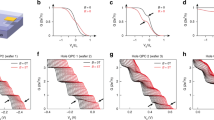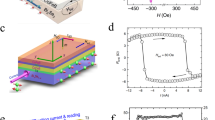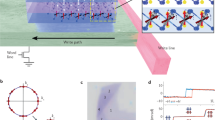Abstract
Understanding the flow of spins in magnetic layered structures has resulted in an increase in data storage density in hard drives over the past decade of more than two orders of magnitude1. Following this remarkable success, the field of ‘spintronics’ or spin-based electronics1,2,3 is moving beyond effects based on local spin polarization and is turning towards spin–orbit interaction (SOI) effects, which hold promise for the production, detection and manipulation of spin currents, allowing coherent transmission of information within a device1,2. Although SOI-induced spin transport effects have been observed in two- and three-dimensional samples, these have been subtle and elusive, often detected only indirectly in electrical transport or else with more sophisticated techniques4,5,6,7,8,9. Here we present the first observation of a predicted ‘spin–orbit gap’ in a one-dimensional sample, where counter-propagating spins, constituting a spin current, are accompanied by a clear signal in the easily measured linear conductance of the system10,11. We first introduce the class of phenomena we dub ‘the one-dimensional spin–orbit gap’ using a simple example adapted from ref. 10, then describe our experiment in detail and finally present a more elaborate model that captures most of the features seen in our data.
This is a preview of subscription content, access via your institution
Access options
Subscribe to this journal
Receive 12 print issues and online access
$259.00 per year
only $21.58 per issue
Buy this article
- Purchase on SpringerLink
- Instant access to full article PDF
Prices may be subject to local taxes which are calculated during checkout





Similar content being viewed by others
References
Fert, A. Nobel lecture: Origin, development, and future of spintronics. Rev. Mod. Phys. 80, 1517–1530 (2008).
Bratkovsky, A. M. Spintronic effects in metallic, semiconductor, metal-oxide and metal–semiconductor heterostructures. Rep. Prog. Phys. 71, 026502 (2008).
Žutić, I., Fabian, J. & Das Sarma, S. Spintronics: Fundamentals and applications. Rev. Mod. Phys. 76, 323–410 (2004).
Kato, Y. K., Myers, R. C., Gossard, A. C. & Awschalom, D. D. Observation of the spin Hall effect in semiconductors. Science 306, 1910–1913 (2004).
Sih, V. et al. Generating spin currents in semiconductors with the spin Hall effect. Phys. Rev. Lett. 97, 096605 (2006).
König, M. et al. Quantum spin Hall insulator state in HgTe quantum wells. Science 318, 766–770 (2007).
Frolov, S. M. et al. Ballistic spin resonance. Nature 458, 868–871 (2009).
Chen, Y. L. et al. Experimental realization of a three-dimensional topological insulator, Bi2Te3 . Science 325, 178–181 (2009).
Xia, Y. et al. Observation of a large-gap topological-insulator class with a single Dirac cone on the surface. Nature Phys. 5, 398–402 (2009).
Pershin, Y. V., Nesteroff, J. A. & Privman, V. Effect of spin–orbit interaction and in-plane magnetic field on the conductance of a quasi-one-dimensional system. Phys. Rev. B 69, 121306(R) (2004).
Zhang, S., Liang, R., Zhang, E., Zhang, L. & Liu, Y. Magnetosubbands of semiconductor quantum wires with Rashba and Dresselhaus spin–orbit coupling. Phys. Rev. B 73, 155316 (2006).
Griffiths, D. J. Introduction to Electrodynamics 3rd edn (Prentice Hall, 1998).
Winkler, R. Spin–Orbit Coupling Effects in Two-Dimensional Electron and Hole Systems Vol. 191 (Springer Tracts in Modern Physics, Springer, 2003).
Elliott, R. J. Theory of the effect of spin–orbit coupling on magnetic resonance in some semiconductors. Phys. Rev. 96, 266–279 (1954).
Cronenwett, S. M. Coherence, Charging and Spin Effects in Quantum Dots and Point Contacts. PhD thesis, Stanford Univ. (2001).
Kouwenhoven, L. P. et al. Nonlinear conductance of quantum point contacts. Phys. Rev. B 39, 8040–8043 (1989).
Glazman, L. I. & Khaetskii, A. V. Nonlinear quantum conductance of a point contact. JETP Lett. 48, 591–595 (1998).
Wu, C., Bernevig, B. A. & Zhang, S.-C. Helical liquid and the edge of quantum spin Hall systems. Phys. Rev. Lett. 96, 106401 (2006).
Pfeiffer, L. et al. Formation of a high quality two-dimensional electron gas on cleaved GaAs. Appl. Phys. Lett. 56, 1697–1699 (1990).
Pfeiffer, L. N., de Picciotto, R., Quay, C. H. L., West, K. W. & Baldwin, K. W. Ballistic hole transport in a quantum wire. Appl. Phys. Lett. 87, 073111 (2005).
Manfra, M., Pfeiffer, L., West, K., de Picciotto, R. & Baldwin, K. High mobility two-dimensional hole system in GaAs/AlGaAs quantum wells grown on (100) GaAs substrates. Appl. Phys. Lett. 86, 162106 (2005).
Klochan, O. et al. The interplay between one-dimensional confinement and two-dimensional crystallographic anisotropy effects in ballistic hole quantum wires. New J. Phys. 11, 043018 (2009).
Danneau, R. et al. Zeeman splitting in ballistic hole quantum wires. Phys. Rev. Lett. 97, 026403 (2006).
Kuemmeth, F., Ilani, S., Ralph, D. C. & McEuen, P. L. Coupling of spin and orbital motion of electrons in carbon nanotubes. Nature 452, 448–452 (2008).
de Picciotto, R. et al. 2D–1D coupling in cleaved edge overgrowth. Phys. Rev. Lett. 85, 1730–1733 (2000).
Auslaender, O. et al. Tunneling spectroscopy of the elementary excitations in a one-dimensional wire. Science 295, 825–828 (2002).
Yacoby, A., Stormer, H. L., Baldwin, K. W., Pfeiffer, L. N. & West, K. W. Magneto-transport spectroscopy on a quantum wire. Solid State Commun. 101, 77–1 (1997).
Auslaender, O. M. et al. Spin-charge separation and localization in one dimension. Science 208, 88–92 (2005).
Acknowledgements
We thank P. Joyez, M. A. Wistey, J. E. Moore and A. S. Goldhaber for helpful discussions and/or comments on the manuscript. J.A.S. acknowledges support from a National Science Foundation graduate fellowship, C.Q.H.L. support from a Harvey Fellowship and Bell Labs, and D.G.-G. a Fellowship from the David and Lucile Packard Foundation and a Hellman Faculty Scholar Award. Work at Stanford was primarily supported by the AFOSR under contracts FA9550-04-1-0384 (PECASE) and FA9550-08-1-0427.
Author information
Authors and Affiliations
Contributions
K.W.W. and L.N.P. carried out the molecular beam epitaxy growth, R.d.P. and C.Q.H.L. the rest of the sample fabrication. K.W.B. characterized the 2DHGs before the cleave as well as control samples from the overgrowth step. R.d.P., C.Q.H.L. and J.A.S. carried out measurements. T.L.H. derived the theoretical model with input from R.d.P. and C.Q.H.L. C.Q.H.L., R.d.P., D.G.-G., T.L.H. and J.A.S. analysed the data. C.Q.H.L. wrote the manuscript together with R.d.P., D.G.G. and T.L.H. R.d.P. and L.N.P. had the idea for the experiment.
Corresponding author
Ethics declarations
Competing interests
The authors declare no competing financial interests.
Supplementary information
Supplementary Information
Supplementary Information (PDF 1590 kb)
Rights and permissions
About this article
Cite this article
Quay, C., Hughes, T., Sulpizio, J. et al. Observation of a one-dimensional spin–orbit gap in a quantum wire. Nature Phys 6, 336–339 (2010). https://doi.org/10.1038/nphys1626
Received:
Accepted:
Published:
Issue date:
DOI: https://doi.org/10.1038/nphys1626
This article is cited by
-
Thermodynamic Properties of Conical Quantum Dot Modulated by External Fields and Rashba Spin–Orbit Interaction
Journal of Low Temperature Physics (2023)
-
Determinants of interchain coupling properties of Te atomic chains
Scientific Reports (2022)
-
Optical absorption of conduction electrons in semiconductor nanowires in the presence of the electron–phonon interaction
Applied Physics B (2022)
-
Non-Majorana states yield nearly quantized conductance in proximatized nanowires
Nature Physics (2021)
-
New signatures of the spin gap in quantum point contacts
Nature Communications (2021)



